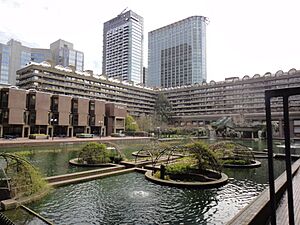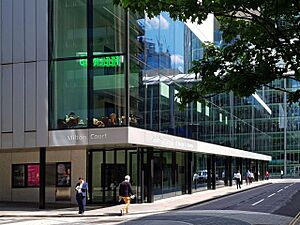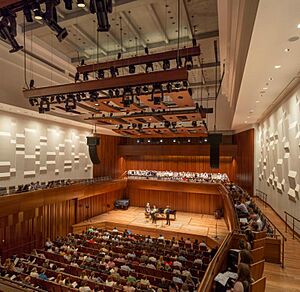Guildhall School of Music and Drama facts for kids
| Type | Music conservatoire Drama school |
|---|---|
| Established | 27 September 1880 |
| Chairman | Emily Benn |
| Principal | Jonathan Vaughan |
| Patron | Lord Mayor of London |
| Students | (2015/16) |
| Undergraduates | (2015/16) |
| Postgraduates | (2015/16) |
| Location |
Silk Street, City of London, England
|
| Campus | Urban |
| Owner | City of London Corporation |
| Affiliations |
|
The Guildhall School of Music and Drama is a famous school in London, England. It teaches music and drama. It started in 1880. Students from over 70 countries come here to learn. They study classical music, jazz, acting, and how to work behind the scenes in theatre. The school is known as one of the best in the world for performing arts.
The school is located inside the Barbican Centre in the City of London. It has just over 1,000 students. About 800 students study music. The other 200 students are in drama or technical theatre programs. Guildhall School works closely with the Barbican Centre and the London Symphony Orchestra. Many famous people have studied here, like Daniel Craig and Michaela Coel.
Contents
History of Guildhall School
How Guildhall School Started (1880–1977)
The Guildhall School of Music first opened on September 27, 1880. It was in an old warehouse in the City of London. It was the first music college in Great Britain run by a city. At first, it had 64 part-time students.
The school quickly grew too big for its first home. In 1887, it moved to a new building on John Carpenter Street. This new building was part of a group of schools built by the City of London. The Lord Mayor of London, Sir Reginald Hanson, opened the new building. Thomas Henry Weist Hill was the first principal. He had about 90 teachers working with him.
The new building was designed by Sir Horace Jones. It had 45 studios for teaching. Each studio had thick concrete walls to block sound. Every room had both a grand piano and an upright piano. There was also a special room for the organ. A small concert hall was used for orchestra and choir practice. This hall also hosted school concerts every two weeks.
At first, all lessons were part-time. But in 1920, full-time courses were added. The school also started teaching speech, voice, and acting. By 1935, the school added "and Drama" to its name.
Guildhall School's Modern Era (1977–Present)
In 1977, the school moved to its current home. This is in the middle of the Barbican Centre in the City of London. The City of London still owns and funds the school.
In 1993, the school got a student hall called Sundial Court. It's about a three-minute walk from the school. Sundial Court has single rooms for 178 students. In 2001, the Barbican Centre, including the Guildhall School, became a Grade II listed building. This means it's a special building that needs to be protected.
The school has won the Queen's Anniversary Prize twice. Once in 2005 for its Guildhall Connect program. Again in 2007 for its opera program. The school was also ranked as the top specialist school in the UK in 2013 and 2014.
A big new building called Milton Court opened in 2013. It cost £90 million. This building has three new performance spaces. There's a concert hall with 608 seats. There's also a theatre with 223 seats and a studio theatre. Milton Court also has teaching rooms for drama.
The school offers programs for university students. It also has Junior Guildhall, a Saturday school for young students aged 4 to 18. In 2014, the school changed its logo to a more modern design.
What You Can Study at Guildhall School
The Guildhall School can give out its own university degrees since 2014. Higher-level degrees are approved by City, University of London.
Music Programs
The Guildhall School has a four-year program for musicians. They also offer advanced master's and diploma programs. Students can focus on classical or jazz music. They can learn to play instruments or sing. Other options include composition, historical music, and electronic music. Master's students can also specialize in Opera Studies. The school also offers degrees in writing opera and music therapy.
Drama Programs
The school offers a three-year BA Honours in Acting. This program prepares students for professional theatre. There is also an MA in Acting. The school works with the Central Academy of Drama in Beijing. They offer a four-year acting program together. Students spend two years at each school. This helps them learn about acting in different cultures.
Production Arts Programs
The school also has a three-year degree in production arts. Students learn how to work behind the scenes in theatre. They can specialize in stage management, costumes, theatre technology, or design. The school teaches special skills like computer-controlled flying systems for stages.
Youth Learning Programs
Guildhall School has a Saturday school for talented young musicians. These students are under 18. The school also helps provide music education to many younger students across the UK. This includes working with the Centre for Young Musicians (CYM).
How to Get In
Getting into the Guildhall School of Music and Drama is very competitive. Students must pass a difficult audition. For music programs, auditions are held in London, New York, Hong Kong, Seoul, Taipei, and Tokyo. For drama, auditions are held in many UK cities and in New York.
For the Production Arts course, students have an interview. This happens at the school's Milton Court building in London. Sometimes, interviews are held at a theatre technology conference in the US. Students meet staff and do activities that show what the course is like.
In 2018/19, the Acting course had 2,610 applications. Only about 1% of applicants were offered a place. This makes it one of the hardest schools to get into in the UK. Students apply directly to the school, not through a central system.
School Buildings and Spaces
The Milton Court Concert Hall is a professional concert venue. It has 608 seats. This is the largest concert hall at any London music school. The school works with the Barbican Centre to host public performances. Famous groups perform here, like the Academy of Ancient Music.
Besides the concert hall, Milton Court has other spaces. There is a theatre with 223 seats. There is also a flexible studio theatre with up to 128 seats. Many rehearsal rooms are also in this building.
The school's Silk Street building is a Grade II listed building. It has a theatre for drama and opera with 308 seats. There is also a smaller concert hall and a recital room. The building has workshops for theatre, electronic music studios, and recording studios. It also has over 40 teaching and practice rooms.
The school also owns the John Hosier Annexe. This nearby building has 44 more teaching and practice rooms. The Guildhall School library is in the Silk Street building. It has one of the largest collections of music and drama books in Europe. The Guildhall Symphony Orchestra often performs at the nearby Barbican Hall. This hall has 1,943 seats.
Famous People Who Studied Here
Many talented people have studied at the Guildhall School.
Music Alumni
- Sir Bryn Terfel (singer)
- Sir James Galway (flautist)
- Jacqueline du Pré (cellist)
- Alison Balsom (trumpeter)
- Thomas Adès (composer)
- Debbie Wiseman (film composer)
- Sir George Martin (composer and record producer for The Beatles)
- Jules Buckley (conductor)
- Myleene Klass (singer and pianist)
Drama Alumni
- Naveen Andrews (actor in Lost)
- Hayley Atwell (actress in Captain America: The First Avenger)
- Orlando Bloom (actor in The Lord of the Rings)
- Michaela Coel (actress and writer of I May Destroy You)
- Daniel Craig (actor, known for playing James Bond)
- Peter Cushing (actor in Star Wars)
- Michelle Dockery (actress in Downton Abbey)
- Joseph Fiennes (actor in Shakespeare in Love)
- Lily James (actress in Cinderella)
- Damian Lewis (actor in Homeland)
- Ewan McGregor (actor in Star Wars)
- Alfred Molina (actor in Spider-Man 2)
- Simon Russell Beale (actor)
- David Thewlis (actor in Fargo)
- Dominic West (actor in The Wire)
- Jodie Whittaker (actress in Doctor Who)
Technical Theatre Alumni
- Judy Craymer (producer of Mamma Mia!)
- Eric Fellner (film producer)
See also
 In Spanish: Guildhall School of Music and Drama para niños
In Spanish: Guildhall School of Music and Drama para niños





